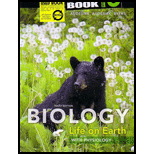
To list: The light-capturing molecules in chloroplasts and also describe its functions.
Introduction:
Chloroplast is the only cell organelle which is found in leaves of plants. It helps in photosynthesis by converting light energy into chemical energy to produce food for plants in the form of glucose which is stored in leaves of the plant in the form of sucrose.
To draw: The molecules found within thylakoid membrane and also explain how they capture and transfer light energy.
Introduction:
The photosynthesis is a process in which the green plants and algae obtains their nutrients. This process takes place in chloroplast where chlorophyll molecules are present. The chloroplast contains thylakoid molecules where light reaction takes place. The end product of the light reaction is the formation of ATP and NADPH which is an energy storing molecule which together helps in driving the Calvin cycle in stroma of chloroplast.
To describe: The products of light reactions and role of each product.
Introduction:
The light reactions take place in the thylakoid membrane of chloroplast where the two photosystem units are present. This light reaction of photosyntesis is also called as Z scheme because the light first strike to photosystem unit I where
To explain: The process of generation of ATP.
Introduction:
Adenosine triphosphate (ATP) is the “energy currency” of cells, which is required to carry out all the cellular processes. ATP within cells acts as an instant source of energy. Guanosine triphosphate (GTP) is another energy rich
Trending nowThis is a popular solution!

 Human Anatomy & Physiology (11th Edition)BiologyISBN:9780134580999Author:Elaine N. Marieb, Katja N. HoehnPublisher:PEARSON
Human Anatomy & Physiology (11th Edition)BiologyISBN:9780134580999Author:Elaine N. Marieb, Katja N. HoehnPublisher:PEARSON Biology 2eBiologyISBN:9781947172517Author:Matthew Douglas, Jung Choi, Mary Ann ClarkPublisher:OpenStax
Biology 2eBiologyISBN:9781947172517Author:Matthew Douglas, Jung Choi, Mary Ann ClarkPublisher:OpenStax Anatomy & PhysiologyBiologyISBN:9781259398629Author:McKinley, Michael P., O'loughlin, Valerie Dean, Bidle, Theresa StouterPublisher:Mcgraw Hill Education,
Anatomy & PhysiologyBiologyISBN:9781259398629Author:McKinley, Michael P., O'loughlin, Valerie Dean, Bidle, Theresa StouterPublisher:Mcgraw Hill Education, Molecular Biology of the Cell (Sixth Edition)BiologyISBN:9780815344322Author:Bruce Alberts, Alexander D. Johnson, Julian Lewis, David Morgan, Martin Raff, Keith Roberts, Peter WalterPublisher:W. W. Norton & Company
Molecular Biology of the Cell (Sixth Edition)BiologyISBN:9780815344322Author:Bruce Alberts, Alexander D. Johnson, Julian Lewis, David Morgan, Martin Raff, Keith Roberts, Peter WalterPublisher:W. W. Norton & Company Laboratory Manual For Human Anatomy & PhysiologyBiologyISBN:9781260159363Author:Martin, Terry R., Prentice-craver, CynthiaPublisher:McGraw-Hill Publishing Co.
Laboratory Manual For Human Anatomy & PhysiologyBiologyISBN:9781260159363Author:Martin, Terry R., Prentice-craver, CynthiaPublisher:McGraw-Hill Publishing Co. Inquiry Into Life (16th Edition)BiologyISBN:9781260231700Author:Sylvia S. Mader, Michael WindelspechtPublisher:McGraw Hill Education
Inquiry Into Life (16th Edition)BiologyISBN:9781260231700Author:Sylvia S. Mader, Michael WindelspechtPublisher:McGraw Hill Education





